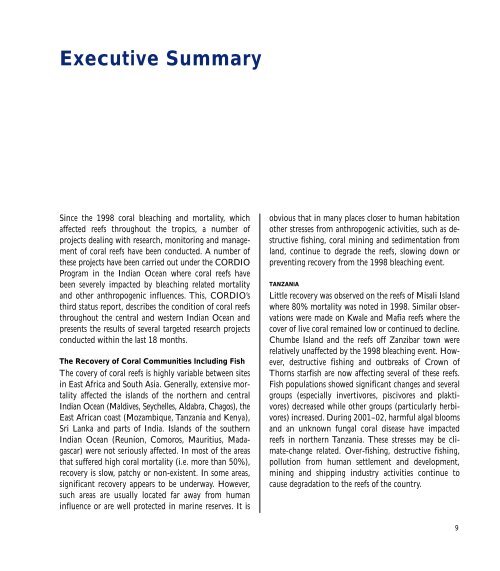Create successful ePaper yourself
Turn your PDF publications into a flip-book with our unique Google optimized e-Paper software.
Executive Summary<br />
Since the 1998 coral bleaching and mortality, which<br />
affected reefs throughout the tropics, a number of<br />
projects dealing with research, monitoring and management<br />
of coral reefs have been conducted. A number of<br />
these projects have been carried out under the <strong>CORDIO</strong><br />
Program in the Indian Ocean where coral reefs have<br />
been severely impacted by bleaching related mortality<br />
and other anthropogenic influences. This, <strong>CORDIO</strong>’s<br />
third status report, describes the condition of coral reefs<br />
throughout the central and western Indian Ocean and<br />
presents the results of several targeted research projects<br />
conducted within the last 18 months.<br />
The Recovery of Coral Communities Including Fish<br />
The covery of coral reefs is highly variable between sites<br />
in East Africa and South Asia. Generally, extensive mortality<br />
affected the islands of the northern and central<br />
Indian Ocean (Maldives, Seychelles, Aldabra, Chagos), the<br />
East African coast (Mozambique, Tanzania and Kenya),<br />
Sri Lanka and parts of India. Islands of the southern<br />
Indian Ocean (Reunion, Comoros, Mauritius, Madagascar)<br />
were not seriously affected. In most of the areas<br />
that suffered high coral mortality (i.e. more than 50%),<br />
recovery is slow, patchy or non-existent. In some areas,<br />
significant recovery appears to be underway. However,<br />
such areas are usually located far away from human<br />
influence or are well protected in marine reserves. It is<br />
obvious that in many places closer to human habitation<br />
other stresses from anthropogenic activities, such as destructive<br />
fishing, coral mining and sedimentation from<br />
land, continue to degrade the reefs, slowing down or<br />
preventing recovery from the 1998 bleaching event.<br />
TANZANIA<br />
Little recovery was observed on the reefs of Misali Island<br />
where 80% mortality was noted in 1998. Similar observations<br />
were made on Kwale and Mafia reefs where the<br />
cover of live coral remained low or continued to decline.<br />
Chumbe Island and the reefs off Zanzibar town were<br />
relatively unaffected by the 1998 bleaching event. However,<br />
destructive fishing and outbreaks of Crown of<br />
Thorns starfish are now affecting several of these reefs.<br />
Fish populations showed significant changes and several<br />
groups (especially invertivores, piscivores and plaktivores)<br />
decreased while other groups (particularly herbivores)<br />
increased. During 2001–02, harmful algal blooms<br />
and an unknown fungal coral disease have impacted<br />
reefs in northern Tanzania. These stresses may be climate-change<br />
related. Over-fishing, destructive fishing,<br />
pollution from human settlement and development,<br />
mining and shipping industry activities continue to<br />
cause degradation to the reefs of the country.<br />
9


















